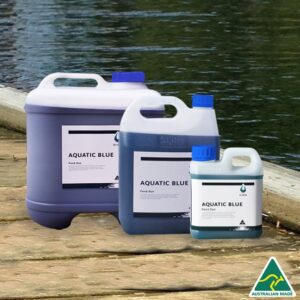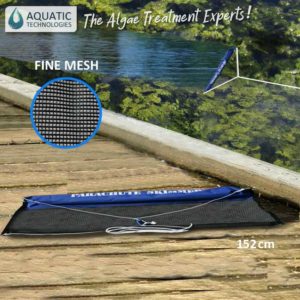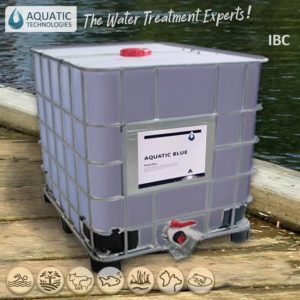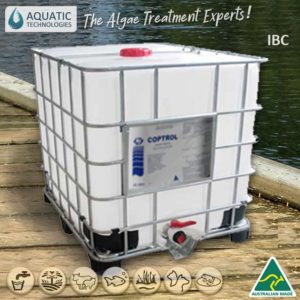Coptrol™ with High pH / Saltwater Stabiliser Additive
For Treating Algae in Saline Water
- Kills problem algae (including cyanobacteria)
- Fast-acting
- Completely safe
- APVMA approved
- Suitable for commercial waterbodies with high salt and/or pH challenging environments
(inc. holding dams, mining tailing ponds, aquaculture, wastewater treatment lagoons & more)
Enquire about this product
Enhancing Algae Control in Saline Water: Harness the combination of Coptrol and our new Saltwater Coptrol Additive
Algae growth in saline water poses significant challenges for water treatment professionals. Algae in salt water not only affects water quality but also disrupts ecosystems and various industrial processes. To address this concern, a new approach using the combined potential of Coptrol and our new “Saltwater Coptrol Additive” emerges as a promising solution for effective algae treatment in saline environments, excluding natural waterways such as estuaries, channels and lagoons. Using a combination of Coptrol and “Saltwater Coptrol Additive”, this algae treatment strategy is effective in reducing algae by up to 95% in commercial water with high salt and/or pH challenging environments. Examples of where Coptrol can be used with our Saltwater Coptrol Additive include commercial holding dams, mining tailing ponds, aquaculture, wastewater treatment, etc.
Understanding the Components:
Coptrol: Coptrol is an APVMA approved aquatic algaecide with proven performance in freshwater bodies. Coptrol is efficient and offers controlled release and stability of algaecide molecules, enabling the precise targeting of algal populations while minimising cost and environmental impact.
Saltwater Coptrol Additive: This new formulation aids in binding and sequestering competing ions in saltwater, thus enhancing the performance of Coptrol for improved algaecide action.
Unveiling the Synergistic Power:
Combining Coptrol and Saltwater Coptrol Additive offers a synergy that revolutionises algae treatment in saline waters. The special Saltwater Coptrol Additive enhances the performance of Coptrol by reinforcing its chelating capacity and stabilising the bioavailability of copper and salt ions.
Advantages of Coptrol over Copper Sulphate:
Coptrol, in comparison to copper sulphate, stands as the preferred choice in water treatment for several reasons:
- Reduced Environmental Impact: Coptrol, due to its controlled release and targeted action, minimises the risk of unintended harm to non-target species and ecosystems.
- Enhanced Stability: Coptrol remains more stable in water, providing a sustained and consistent impact on algae while avoiding rapid degradation.
- Efficiency in Saline and high pH Environments: Coptrol’s effectiveness is less affected by high salinity aand pH levels compared to copper sulphate when using our special Saltwater Coptrol Additive, making it a more reliable option for treating saline waters without compromising efficacy.
- Cost Effective: Higher efficiency compared to copper sulphate means that less Coptrol is needed to achieve the same effect, which translates to a lower dosage required.
The combined action of Coptrol and Saltwater Coptrol Additive opens up a modern approach to treating algae in saltwater – a challenge that posed significant difficulties in the past. This innovative approach represents a new step in the realm of saltwater algae treatment.
This combined treatment not only improves the effectiveness of Coptrol but also signifies a step towards the preservation of water ecosystems while meeting the demands of various commercial industries reliant on high-quality saline water sources.For dosage recommendations and algae management advice, please contact our team of experienced algae experts.

What types of algae will Coptrol control?
Coptrol will control all types of Algae in water, including (effectively) all types of cyanobacteria (blue-green algae), free-floating and filamentous green algae, including brown slime algae.Specifically, Coptrol will treat Blue Green Algae such as:
● Microcystis (Blue-Green Algae)
● Anabaena (Blue-Green Algae)
● Cyanobacteria (Blue-Green Algae)
● Oscillatoria (Blue-Green Algae)
● Aphanizomenon (Cyanobacteria)
● Dictyosphaerium (Blue-Green Algae) and
● Euglena (Flagellates).Specifically, Coptrol will treat Filamentous algae such as:
● Spirogyra
● Chlorella
● Hydrodictyon
● Cladophora and
● Oedogonium.Specifically, Coptrol will treat Plant Structured algae such as:
● Chara and
● Phormidium.Is Coptrol Safe?
Coptrol is a commercial grade algaecide that is safe and easy to use, APVMA approved and does not harm fish, livestock, plants, pastures or turf irrigated with water treated with Coptrol (when used in accordance with label instructions).
Will Coptrol harm fish?
No, Coptrol will not harm fish or other wildlife (when used in accordance with label instructions).
How does Coptrol work?
Coptrol is an Aquatic Algaecide.
When applied to a body of water, the algae present actively seek out the Coptrol and absorb it for its nutritional value. Once Coptrol is absorbed by the algae through the cell wall, digestive enzymes in the algae cells break down the Coptrol compound and then release the active constituent inside the algae cell to kill it.
Can I use chlorine to kill algae?
Chlorine is not an effective way to kill algae, you won’t get a good kill rate using it. Chlorine is more for bacteria treatment or sterilisation.
Is algae harmful to humans and livestock?
A Harmful Algal Bloom (HAB), most commonly cyanobacteria (blue-green algae), can be toxic to humans and other animals. Algae are microscopic organisms that live in aquatic environments and photosynthesise to gain energy. In excess, these organisms become visible to the naked eye. Algal blooms vary in colour from brown, red, green or blue/green. Environmental factors such as increased temperature, high levels of nutrients (Nitrogen or Phosphorus), abundant sunlight and still or low-flowing water can trigger these events. HABs can lead to serious health effects in humans and animals such as; general paralysis, gastrointestinal illness, respiratory problems, liver damage and even death. Exposure to contaminated water bodies through both primary and secondary activities can lead to illness with mild symptoms similar to those of heat stroke and food poisoning. In the event of a harmful algal bloom, it is imperative that contact with the water body be avoided, including irrigation.
• Download Coptrol Product Brochure PDF
• Download Coptrol SDS PDF
• Download Coptrol vs Copper Sulphate Literature Review PDF
Coptrol is safe in and around water bodies with the following uses:
Description
Enhancing Algae Control in Saline Water: Harness the combination of Coptrol and our new Saltwater Coptrol Additive
Algae growth in saline water poses significant challenges for water treatment professionals. Algae in salt water not only affects water quality but also disrupts ecosystems and various industrial processes. To address this concern, a new approach using the combined potential of Coptrol and our new “Saltwater Coptrol Additive” emerges as a promising solution for effective algae treatment in saline environments, excluding natural waterways such as estuaries, channels and lagoons. Using a combination of Coptrol and “Saltwater Coptrol Additive”, this algae treatment strategy is effective in reducing algae by up to 95% in commercial water with high salt and/or pH challenging environments. Examples of where Coptrol can be used with our Saltwater Coptrol Additive include commercial holding dams, mining tailing ponds, aquaculture, wastewater treatment, etc.
Understanding the Components:
Coptrol: Coptrol is an APVMA approved aquatic algaecide with proven performance in freshwater bodies. Coptrol is efficient and offers controlled release and stability of algaecide molecules, enabling the precise targeting of algal populations while minimising cost and environmental impact.
Saltwater Coptrol Additive: This new formulation aids in binding and sequestering competing ions in saltwater, thus enhancing the performance of Coptrol for improved algaecide action.
Unveiling the Synergistic Power:
Combining Coptrol and Saltwater Coptrol Additive offers a synergy that revolutionises algae treatment in saline waters. The special Saltwater Coptrol Additive enhances the performance of Coptrol by reinforcing its chelating capacity and stabilising the bioavailability of copper and salt ions.
Advantages of Coptrol over Copper Sulphate:
Coptrol, in comparison to copper sulphate, stands as the preferred choice in water treatment for several reasons:
- Reduced Environmental Impact: Coptrol, due to its controlled release and targeted action, minimises the risk of unintended harm to non-target species and ecosystems.
- Enhanced Stability: Coptrol remains more stable in water, providing a sustained and consistent impact on algae while avoiding rapid degradation.
- Efficiency in Saline and high pH Environments: Coptrol’s effectiveness is less affected by high salinity aand pH levels compared to copper sulphate when using our special Saltwater Coptrol Additive, making it a more reliable option for treating saline waters without compromising efficacy.
- Cost Effective: Higher efficiency compared to copper sulphate means that less Coptrol is needed to achieve the same effect, which translates to a lower dosage required.
The combined action of Coptrol and Saltwater Coptrol Additive opens up a modern approach to treating algae in saltwater – a challenge that posed significant difficulties in the past. This innovative approach represents a new step in the realm of saltwater algae treatment.
This combined treatment not only improves the effectiveness of Coptrol but also signifies a step towards the preservation of water ecosystems while meeting the demands of various commercial industries reliant on high-quality saline water sources.For dosage recommendations and algae management advice, please contact our team of experienced algae experts.
How To Use

Targets
What types of algae will Coptrol control?
Coptrol will control all types of Algae in water, including (effectively) all types of cyanobacteria (blue-green algae), free-floating and filamentous green algae, including brown slime algae.Specifically, Coptrol will treat Blue Green Algae such as:
● Microcystis (Blue-Green Algae)
● Anabaena (Blue-Green Algae)
● Cyanobacteria (Blue-Green Algae)
● Oscillatoria (Blue-Green Algae)
● Aphanizomenon (Cyanobacteria)
● Dictyosphaerium (Blue-Green Algae) and
● Euglena (Flagellates).Specifically, Coptrol will treat Filamentous algae such as:
● Spirogyra
● Chlorella
● Hydrodictyon
● Cladophora and
● Oedogonium.Specifically, Coptrol will treat Plant Structured algae such as:
● Chara and
● Phormidium.FAQ
Is Coptrol Safe?
Coptrol is a commercial grade algaecide that is safe and easy to use, APVMA approved and does not harm fish, livestock, plants, pastures or turf irrigated with water treated with Coptrol (when used in accordance with label instructions).
Will Coptrol harm fish?
No, Coptrol will not harm fish or other wildlife (when used in accordance with label instructions).
How does Coptrol work?
Coptrol is an Aquatic Algaecide.
When applied to a body of water, the algae present actively seek out the Coptrol and absorb it for its nutritional value. Once Coptrol is absorbed by the algae through the cell wall, digestive enzymes in the algae cells break down the Coptrol compound and then release the active constituent inside the algae cell to kill it.
Can I use chlorine to kill algae?
Chlorine is not an effective way to kill algae, you won’t get a good kill rate using it. Chlorine is more for bacteria treatment or sterilisation.
Is algae harmful to humans and livestock?
A Harmful Algal Bloom (HAB), most commonly cyanobacteria (blue-green algae), can be toxic to humans and other animals. Algae are microscopic organisms that live in aquatic environments and photosynthesise to gain energy. In excess, these organisms become visible to the naked eye. Algal blooms vary in colour from brown, red, green or blue/green. Environmental factors such as increased temperature, high levels of nutrients (Nitrogen or Phosphorus), abundant sunlight and still or low-flowing water can trigger these events. HABs can lead to serious health effects in humans and animals such as; general paralysis, gastrointestinal illness, respiratory problems, liver damage and even death. Exposure to contaminated water bodies through both primary and secondary activities can lead to illness with mild symptoms similar to those of heat stroke and food poisoning. In the event of a harmful algal bloom, it is imperative that contact with the water body be avoided, including irrigation.
Resources
Videos
Safe For









